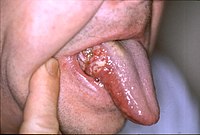
Photo from wikipedia
Objective To investigate the association between dietary fatty acid (FA) patterns and the risk of oral cancer. Method A case-control study which included 446 patients with oral cancer and 448… Click to show full abstract
Objective To investigate the association between dietary fatty acid (FA) patterns and the risk of oral cancer. Method A case-control study which included 446 patients with oral cancer and 448 controls subjects was conducted in Southeast China. A structured food frequency questionnaire was used to assess the dietary FA consumption before cancer diagnosis. FA patterns were identified using the principal component analysis, and the relationship between the dietary FA patterns and oral cancer was analyzed by logistic regression. Results General differences in FA intake were observed between the patient and control groups. The intakes of saturated FAs (SFAs) C14:0, C16:0, C18:0, and monounsaturated FA C18:1 were higher in the patient group than the control group (p < 0.001). Four FA patterns were derived by principal component analysis. The “SFA” pattern, “Polyunsaturated FA” pattern, “Monounsaturated FA” pattern, and “Medium- and long-chain FA” pattern, which could explain 75.7% of the variance of the dietary FA intake, were submitted to logistic regression analysis. A positive association was observed between the “SFA” pattern and oral cancer risk. Compared with the lowest quartile score, the OR of the highest quartile score was 3.71 (95%CI: 2.31, 5.94, Ptrend < 0.001) in the multivariate logistic regression model. No significant association was found among the other three patterns and oral cancer risk. Conclusions General differences in dietary FA intake were observed between patients with oral cancer and controls. A positive association between the “SFA” pattern and risk of oral cancer was observed after adjusting for potential confounders.
Journal Title: Frontiers in Nutrition
Year Published: 2022
Link to full text (if available)
Share on Social Media: Sign Up to like & get
recommendations!